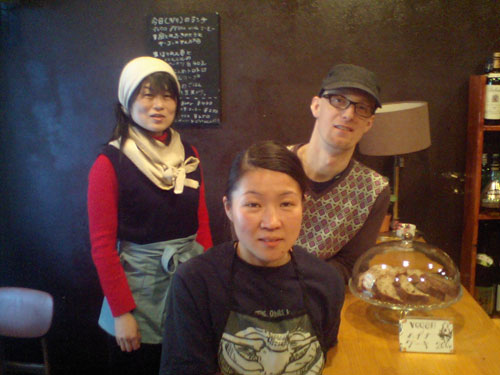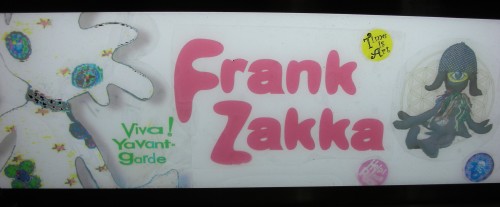ON THE LOOKOUT
I am searching for a b-boy and a b-girl for a short film I am working on. If any MnoT readers know of anyone with talent in this vein, I am all ears!

I am searching for a b-boy and a b-girl for a short film I am working on. If any MnoT readers know of anyone with talent in this vein, I am all ears!
After the 101 Tokyo opening last night (and before the 102 Tokyo Art opening), Jean Snow, Brad D., and I stopped into a Suehirocho Mickey Ds to eat some eco-unfriendly and inexpensive food-units. (Have you tried this “Big” Mac thing they have? It’s huge!)
We were seated next to a conspiciously-filthy group of vagrant-looking older Japanese men and women, who were drifting in and out of sleep and looked to have been camping out in those seats for the entire Fukuda prime minister-ship. Suddenly, the younger woman of this collective pulls out an enormous needle, and as we were fleeing, administered the older guy of the group an insulin shot as he laid down.
Needles and vagrants at a McDonalds? What is this — New York? I am not going to extrapolate this one anecdote into proof of Japanese economic collapse, but I almost feel like Tokyo’s less pleasant underbelly is starting to stick out a bit more, especially in downtown areas. The clerks are still perky young nationals, but the Japanese fast food environment may possibly be on its way to becoming as unpredictable as in other countries.
My new book, Parallel Strokes, will be available at the 101 Tokyo Art Fair, along with many fine publications from the good folks at Chin Music Press. I wrote a related essay in their imminent book, Art Space Tokyo, as well.
Parallel Strokes is now available at Book 246 and On Sundays, the Watari-um bookshop.

Néojaponisme contributor Dwayne Dixon and amazing vegan chefs Yoyo and Yuka offer up the tastiest vegan lunch in Tokyo on Wednesdays at Vegie Shokudou, a renegade restaurant inside of a bar in Koenji. Note that the restaurant operates ONLY ON WEDNESDAYS. There is a break period from 3pm-5pm, and the restaurant will be closed. Eats start at 1PM.
Directions here.
While in Los Angeles, I visited a typical American office, since I had forgotten about the normal corporate environment back home. Although this was in Southern California, it might as well have been in northeastern Pennsylvania. That’s how generic it was.
Here are some pictures I took.




I am actually not at LeBaron. I don’t go to LeBaron. Please stop asking me to attend events there. That club blows megadicks.
I am going to say it now, again, loud and clear for you:
Fuck ¥1000 for shitty beer on tap. The only time I am going to pay that is when it comes with some fancy fucking food. And they don’t have that at LeBaron. Just dudes with asymmetrical haircuts who can’t dj for shit.
Oh, and retards.

Forget “Engrish.” We get it already: sometimes Japanese copywriters are not very good at writing within the English language. You’ve just repeated the same joke 10,000 times.
Let’s try something new: Engrich. Instead of showing the mistakes of Japanese working within English, let’s hunt for examples of brilliant cross-linguistic creation.
The first example: “Frank Zakka.” This Shibuya arty-accessories store’s name is a pun on the musician Frank Zappa and zakka (雑貨) — the Japanese word for accessories. But you already knew that.
Here’s how most style and trend journalism works. Writer or editor hears that “(place) is up-and-coming, cool” or “(person) is hot” or “everyone is in (fashion item).” In the case of an urban neighborhood, the writer then backs up this rumor-based narrative by profiling all the neat stores located in the area. Voila: check out the hippest neighborhood in all of Nippon, Nakameguro.
But think about this New York Times Magazine piece in reverse: are you impressed with the neighborhood by judging it solely on this store listing? (Forget for a minute that Claska has as much to do with Nakameguro as Carrot Tower does.) Although lackluster, these stores are probably the best examples of hipster-chic retail locations still standing since Organic Cafe closed down, super-secret Club New Bach disappeared, Dyezu Gallery closed, the Groovisions store shuttered, the Gas Gallery/Store evaporated, that good Thai place was demolished, and APC Surplus moved up to Daikanyama.
I think everyone likes the laid-back, river feel of Nakameguro, and there is nowhere better to view the cherry blossoms in the peak of sakura season. Cow Books is worth a trip, and sure, I bought my Peugot at that bike shop. And there’s that good Mexican place that foreigners like to go to. And maybe the John Lawrence Sullivan store will be a good addition. However, the bigger question is: after at least eight or nine years of Nakameguro being on the brink of becoming the “Next Big Thing,” when can we admit that it never really reached any sort of peak? And although I don’t dare to use the word “decline,” the stores that forged the neighborhood’s reputation no longer exist. We tend to judge Ginza, Aoyama, and Harajuku by the strength of the retail/gallery environment, and yet, Nakameguro gets by just on its own myth. Rather than new stores, Nakame tends to attract foreigner residents and tourist-reporters.
Apparently, the most important thing for Western conceptions of Tokyo is that someone comes up with a narrative and everyone sticks to it. Don’t worry about the fact that almost none of the major retailers in Japan have decided to put a store there, nor that most indie brands can’t exist there for any extended period of time. (General Research and its literary wing Cow Books moved into Nakameguro so much earlier than anyone else that I think they have some special deal on the rent.) So maybe “Nakame” will now blow us all away by turning into the next Daikanayama (which is also less energetic lately), but at what point do we say, okay, they tried that and it didn’t work. Is the consumer sluggishness making us rehash the old trend narratives until the economy can finally concoct new ones?

The other regular publication that I design is an American hip-hop + r&b magazine called Rap-Up. The editors’ first book on the topic just came out this week. I designed the cover and did the illustrations throughout.
A crowd gathers in Yoyogi park on Sunday afternoon to watch an institution of Tokyo “street” culture: the Fifties Dancers. Oh, Pompadours and Regents! Leather jackets and sunglasses and chest tattoos. I’d seen them in documentaries and cigarette ads, but here they are in the flesh!
No, there has not been a revival of the late 1970s/early 1980s Fifties scene. These are the same “kids” from the original movement, showing up in Yoyogi to dance their silly dances to the classics of early ’80s J-pop as if it were a Theta-Pi Homecoming Tailgate. They’re in their late 40s now, skin as rough and tough as their leather.
Who needs new Japanese street fashion from “rebellious” youth when the middle-aged will drive into the city on the weekends and show the kids how it’s done? Hopefully soon we’ll get some real-deal Takenokozoku grandmothers and Taiyo-zoku zombies rising from the graves of Shonan — that will get this youth culture thing up and moving again! The bandaged Cosuplay freakshow on the bridge just sit there, expecting to be photographed. More dancing, less posing, people.
 |
I thought the whole gyaru thing was RIP, but Popteen is a player in the publishing world, Tsubasa was a big star before her surprise yankii wedding, and this mag Koakuma Ageha is literally the brightest thing on the shelves. The black-face Ganguro are ancient history, but the angelic Koakuma Gyaru are being spun to be “Gyaru + Cosplay” because of the tiaras and lacy dresses. Everyone, however, is ignoring the white elephant in the room. |
Read the Japanese State’s official take on them here — only mentioning the word “hostess” in a single sentence. That’s like only mentioning the word “cocaine” once in describing Crack Whore Monthly.
I was in denial about the hostess-ness of the Koakuma for a while, but actually browsing through an issue of the magazine, I admit defeat: the editorial tone takes for granted that the reader works in the “the night life” or is hoping to once Senior Year at Saitama High School finishes in March. 41% of girls date guys that are “customers.” This doesn’t mean that love bloomed over the cash register at Wendy’s.
Perhaps the word “yankii” is too much rooted in a specific late 1970s fashion, but there is a very resilient aesthetic of the Japanese working classes. They did dark skin and bleached hair before it was “okay.” And that aesthetic guides the all kogyaru/kogal after the original girls as well as the current boys doing O-nii-kei. These subcultures stab the “Japan is a classless society” myth right in the heart. They represent not only a different fashion but a completely set of social mores. These styles are despised and not recognized by the “middle-class” fashion press. The magazines for these styles come from smaller independent publishers. The magazine content presents employment in semi-sexual nightlife services such as hostess and host clubs as not only an option for employment, but the job to take after high school (Host Knuckle, anyone?). There are no sections about “what to wear to your interview with Mitsubishi UFJ Trust & Banking.
Magazines like Egg speak frankly about sexual promiscuity and activity in a way that “mainstream” magazines do not. But more importantly, they set the expectation that everyone gets married around 20, as is normal in Japanese working-class communities (Tsubasa was not pregnant, just “marryin’ age”). Sometimes these marriages don’t work out, however, and everyone heads back to their subcultures. Koakuma Ageha has a special section called シンママ同盟 — “Single Mother Community” — a section I don’t remember seeing in Non•no or even CanCam
Here’s the real question: is the sudden popularity of O-nii-kei and these post-ganguro gyaru further proof of social disparity in Japan? The “working classes” are growing as the middle-class generally descends into lower stratum. Makes sense that more and more rural lower and lower middle class youth see delinquent subcultures as a lower risk than in the past since behaving properly in the education system does not pay off so well anymore. Or perhaps the barriers to entry in the media world are low enough that the working class subcultures can advertise their cultures more. In the past, the Bosozoku did not have their own monthly fashion magazines to teach kids the best places for a weekend gang rape. Now if you want to learn what to wear so that some married Assistant Director of Logistics keeps coming back every Thursday night, you can pick up an issue of Koakuma Ageha at 7-11. Japanese conservatives surely liked it more when the working classes stayed hidden out in the countryside and were not setting “trends in Japan.”
You’d have found it hard to take a train through Tokyo this week without running into Kawakami Mieko, chin in hands and gazing pensively down at you as if to say, “How much more smokey do my eyes have to get before you buy my Akutagawa prize-winning book Chichi to ran (Breasts and eggs), citizen?”
The Akutagawa judging panel must have high-fived each other silly after reaching this decision: A writer this prizeworthy yet also this photogenic! Bungeishunjū certainly wasted no time getting her into the Shūkan Bunshun‘s embarrassing weekly gravure feature, “Illustrated treasury of beautiful girls in natural color” (原色美女図鑑); Kawakami made a dignified, arty appearance there a couple of weeks ago, right after the decision was announced.
Oh, sure, they quote her as asking “Is it really OK for me to appear in [this feature]?”, but don’t mistake her for some reclusive scribbler shading her eyes and blinking as she emerges into the public sphere. She’s already published books, released a couple of CDs, performs live, and appears in Quick Japan, Eureka and the like fairly regularly. It’s not often that a triple threat wins a literary prize, although admittedly in Japan it seems to happen more often than elsewhere.
Incidentally, the “modern Higuchi Ichiyō” angle that Bungeishunjū is working isn’t as vapid as it might seem at first glance. It isn’t just that she wrote poetry before branching out into fiction, and is female (Holy cow, I gotta call my editor!) — she herself actually cites Higuchi’s Takekurabe as an influence on Chichi, and the river-of-words sentence structure she employs is very Higuchid in its way.
The most interesting thing about this Edison Chen scandal — besides the pornographic pictures of celebrities traded around in the name of journalism — is the open discussion of how the Triads may dole out extralegal punishment upon Mr. Chen for bringing such disgrace upon their Hong Kong Entertainment world. This is not idle banter: the president of Emperor Entertainment Group (EEG) and Edison’s former boss Albert Yeung apparently has well-known ties to Chinese organized crime. Even the New York Times today made a note of organized crime involvement within the Hong Kong industry.
Although the Japanese industry is equally rumored to be funded by organized crime, I wonder why there is less open discussion of this fact in either the Western or Japanese press. Mainstream Japanese magazines rarely ever openly talks about the most conspicuously mob-linked “Don of the Japanese Entertainment World” Mr. S*** (ex-chauffeur to mob-linked LDP politician Hamada Kouichi) in the same way as Albert Yeung. Perhaps the international range of the Triads’ financial dealings, especially now since they are investing in Canada, have put them more on the radar than yakuza-backed entertainment companies in Japan, which intentionally stay small in size and scope to avoid being conspicuous. The Mr. S noted above barely appears from a Google Image search, whereas Albert Yeung comes up pretty quickly since he seems to be a public figure. The Japanese guys behind the curtain keep a low profile. They don’t want to be household names.
Interesting parallel though: both Hong Kong and Japan have mob-backed entertainment industries focused on artists within “management companies.” In the past, I have tried to show through data that this industrial organization leads to much more stable artistic standards than markets with “free agents” artists like in the United States (artists directly make deals with labels rather than become employees of middle-men management companies). Historically, “entertainment” in Asia (and elsewhere for that matter) was a risky and low-class venture best funded by organized crime, so I understand why there are still links today. However, is there something about management companies in particular that make them a good opportunity for money laundering and illegal racketeering?

While in Malaysia last year, Selena and I came across this rad seal carver and had seals made. I have an affinity for hanko carvers because they create work in relief and in reverse, like the punchcutters of yore. Much radder to see it done by hand than by a guy doing it on a computer (which is the norm for low-rent seal shops in Asia). If you are ever in Malacca (which is the awesomest city in Asia in my book), hit up King. Read all about it over at PingMag.
[Soundtrack to this post: "Heads Are Gonna Roll" by RFTC]